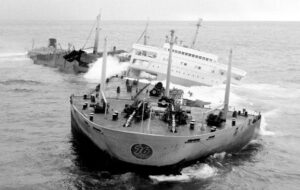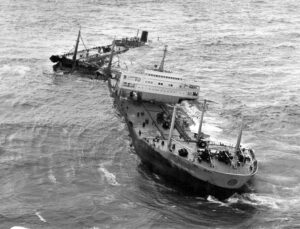 SS Torrey Canyon was a supertanker that was responsible for one of the world’s most serious oil spills. The Torrey Canyon ran aground on rocks off the south-west coast of the United Kingdom in 1967. In all 25 -36 million gallons of crude oil was spilled. There were a number of attempts to mitigate the damage, one of which was to actually bomb the wreck by aircraft from the Royal Navy and Royal Air Force. I guess they thought the bombing would burn up the oil. Unfortunately, that was not the case, and hundreds of miles of coastline in Britain, France, Guernsey, and Spain were affected by the oil spill and other substances used in the attempt to mitigate damage. Even the “solution” was a big problem. The disaster was the world’s worst oil spill and led to significant changes in maritime law and oil spill responses.
SS Torrey Canyon was a supertanker that was responsible for one of the world’s most serious oil spills. The Torrey Canyon ran aground on rocks off the south-west coast of the United Kingdom in 1967. In all 25 -36 million gallons of crude oil was spilled. There were a number of attempts to mitigate the damage, one of which was to actually bomb the wreck by aircraft from the Royal Navy and Royal Air Force. I guess they thought the bombing would burn up the oil. Unfortunately, that was not the case, and hundreds of miles of coastline in Britain, France, Guernsey, and Spain were affected by the oil spill and other substances used in the attempt to mitigate damage. Even the “solution” was a big problem. The disaster was the world’s worst oil spill and led to significant changes in maritime law and oil spill responses.
The Torrey Canyon was built in the United States in 1959. She originally had a capacity of 60,000 tons, but that was later enlarged to 120,000 tons in Japan. She was named for Torrey Canyon, a valley located in Ventura County, California. SS Torrey Canyon was registered in Liberia and owned by Barracuda Tanker Corporation, which is a subsidiary of Union Oil Company of California, but she was chartered to British Petroleum. SS Torrey Canyon was 974.4 feet long, with a 125.4 feet beam and a 68.7 feet draught.
On February 19, 1967, SS Torrey Canyon began what was to be her final voyage. She left the Kuwait National Petroleum Company refinery at Mina Al-Ahmadi, Kuwait, which was later called Al-Ahmadi, with a full cargo of crude oil. The ship was bound for Milford Haven in Wales. By March 14, she reached the Canary Islands. After  that, things went wrong. It all started with a navigational error and ended when Torrey Canyon struck Pollard’s Rock on the extreme Western end of the Seven Stones between the Cornish mainland and the Isles of Scilly on March 18, 1967.
that, things went wrong. It all started with a navigational error and ended when Torrey Canyon struck Pollard’s Rock on the extreme Western end of the Seven Stones between the Cornish mainland and the Isles of Scilly on March 18, 1967.
Because SS Torrey Canyon did not have a scheduled route and she also didn’t have the necessary complement of full-scale charts of the Scilly Islands. Before long the crew of the SS Torrey Canyon found themselves on a collision course with a fishing fleet. The Master and the officer of the watch disagreed as to their exact position. Uncertainty as to whether the vessel was in manual or automatic steering mode significantly delayed corrective action, with the Master mistakenly believing he had switched the steering to manual for the helmsman. By the time they realized that they had not corrected the steering problem, they were too close to the rocks, and a grounding was unavoidable. Thus, began hours and days of extensive attempts to float the vessel off the reef, all of which failed and even resulted in the death of Captain Hans Barend Stal, a member of the Dutch salvage team.
Despite repeated attempts, the ship would not move off the rocks, and began to break up. Immediately thereafter, the focus changed to concentrating on the clean-up and containment of the resulting oil spill. The Cornwall Fire Brigade used huge amounts of detergent and attending Royal Navy vessels to try to disperse the oil. Then the UK Prime Minister Harold Wilson and his cabinet held a mini cabinet meeting at the Royal Naval Air Station Culdrose. The decision was made to set fire to the vessel and surrounding oil slick to limit the extent of the oil disaster. Then, on March 28, 1967, the Fleet Air Arm sent Blackburn Buccaneer planes from RNAS Lossiemouth to drop forty-two 1,000-pound bombs on the ship. The Royal Air Force sent Hawker Hunter jets  from RAF Chivenor to drop cans of aviation fuel to make the oil blaze. Unfortunately, exceptionally high tides put the fire out. The winds made it necessary to make further bombing runs by Sea Vixens from the RNAS Yeovilton and Buccaneers from the Royal Navy Air Station Brawdy, as well as more RAF Hunters with liquefied petroleum jelly, also known as napalm, to ignite the oil. The constant bombing lasted into the next day before the Torrey Canyon finally sank. About 161 1,000-pound bombs, 13,000 US gallons of kerosene, 3,600 US gallons of napalm and 16 other missiles had been aimed at the ship. Attempts to use foam-filled containment booms were mostly ineffectual because of the high seas. The disaster finally over, there was nothing left but the cleanup.
from RAF Chivenor to drop cans of aviation fuel to make the oil blaze. Unfortunately, exceptionally high tides put the fire out. The winds made it necessary to make further bombing runs by Sea Vixens from the RNAS Yeovilton and Buccaneers from the Royal Navy Air Station Brawdy, as well as more RAF Hunters with liquefied petroleum jelly, also known as napalm, to ignite the oil. The constant bombing lasted into the next day before the Torrey Canyon finally sank. About 161 1,000-pound bombs, 13,000 US gallons of kerosene, 3,600 US gallons of napalm and 16 other missiles had been aimed at the ship. Attempts to use foam-filled containment booms were mostly ineffectual because of the high seas. The disaster finally over, there was nothing left but the cleanup.


Leave a Reply